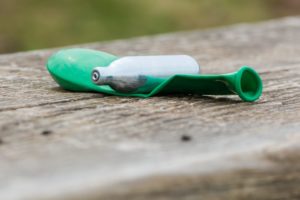Inhalant abuse is often referred to as volatile substance abuse, solvent abuse, sniffing, huffing, and bagging. This is the deliberate act of inhaling a volatile substance to achieve an altered mental state. Inhalant abuse is a problem in the United States, and it is actually a global issue, too. It is more common in minority and marginalized populations and often affects younger children when compared to other forms of substance abuse. Those who chronically abuse inhalants are often met with serious and irreversible effects.
Inhalants are sought out due to their low cost and easy access. These drugs can produce an intense euphoric high. The National Institute on Drug Abuse (NIDA) released a report about its users that shows that 9.8 percent of adults ages 18-25 most commonly engage in inhalant use. Other reports show that 10th-graders (6.1 percent) also regularly experiment with inhalants. When students enter the eighth grade, a staggering 1 in 5 of their classmates will have already experimented with deadly inhalant drugs.
Inhalants include aerosols, solvents, and nitrates, among others. While inhalant addiction is less common, it has been depicted in history for centuries, dating back to Babylonian times. Inhalant use gained popularity in the United States during the alcohol Prohibition period in the U.S. This was used as a substitute for alcohol as a means to “catch a buzz.” It wasn’t until later, however, that abuse of the drugs was popularized.
The unfortunate reality is that while not all who try it will become addicted, some will fall into the grips of addiction. Inhalants can be purchased at gas stations, tobacco stores, and even convenience stores, which raise the level of concern. More efforts are needed to regulate inhalants, and more information about inhalant addiction will be discussed below.
Inhalant Misuse

There are various meanings of inhalants, but when referring to inhalant addiction, it means the inhalation of a solvent or other material that produces vapors users inhale to get high. These can be found in many household products that serve their purpose at home.
Inhalants contain 1,1-difluoroethane, a colorless gas found in aerosol products such as cleaning aerosols and sprays. Dust-Off is one of the brand-name inhalants most commonly abused. It is bought legally in most office supply and hardware stores in the United States.
Unfortunately, they can carry a high risk of abuse. The National Inhalant Prevention Coalition shows that children quickly discover that these household products are not only inexpensive to buy but very easy to hide. The most common inhalants are paint and glue, but thousands of household chemicals can be abused.
Inhalants have the ability to produce psychoactive and mind-altering effects that can cause just as severe side effects that include apathy, belligerence, impaired functions, vomiting, nausea, and dizziness. It is a very intense intoxication that can cause the user to have trouble completing simple tasks such as walking.
The leading cause of death from using inhalants is the trauma that can result after consumption. Gases are cold, and inhaling these can result in freezing the lungs. This is why if you’ve seen someone use inhalants, their lips turn blue due to oxygen deprivation. The leading cause of death, however, is falls caused by losing consciousness. This can also lead to seizures, or something called Sudden Sniffing Death Syndrome.
Most Common Inhalants
- Cleaning aerosols, cleaning sprays
- Paint thinners & degreasers
- Nitrites
- Gases
How Inhalants Work
Inhalant use results in a high associated with euphoria stemming from the central nervous system (CNS). Inhalant abuse affects many areas of the brain, but as the high fades, it acts as a depressant. It’s a short high that requires the individual to continue redosing so they can achieve their desired level of intoxication.
Constant inhalant use causes extreme dizziness by starving the brain of oxygen, and this causes what is called brain fog. Due to this, it runs the risk of severe health problems when motor skills are affected in this dramatic fashion. When the user continues to inhale the substance, it can cause aggression and possible hallucinations. This puts not only the user in harm’s way but anyone around them as well. These hallucinations can transport someone into an alternate existence, causing them to exhibit strange behaviors and acts that could kill them.
Inhalants affect the brain like other depressants and drugs by activating dopamine in the system. This is the body’s natural pleasure center. The difference between inhalants and other drugs, though, is how deadly it can be after a single use. While other drugs may require several uses to become fatal, inhalants can kill you even after trying them for the first time. Brain damage is also linked to long-term use. To avoid these problems and reduce any damage to the body, it is important to seek help immediately if you suspect a growing substance use disorder from inhalant use.
Effects of Inhalant Abuse
Children are drawn to inhalants because it is harder to detect when the substances are being abused. Fortunately, if you are familiar with the signs of inhalant abuse, there will be outward signs that you can recognize.
Signs of Abuse
- Inattentiveness, a lack of coordination, irritability, and depression
- Vomiting or appetite loss
- Slurred speech
- Hidden spray paint or solvent containers, or chemical-soaked rags/clothing
- Appearing drunk or disoriented
- Paint or other stains on the face, hands, or clothes
- Chemical odors on breath or clothing
For those who develop an addiction to inhalants, the drug will become the center of their universe. The signs will become easier to identify.
Behaviors of Long-Term Inhalant Users
- Aggressive behavior
- Increased anger
- Deviant behavior
- Delinquency
- School truancy
- Antisocial behavior
Early detection is key to preventing damage and saving someone’s life. If you suspect your loved one is becoming dependent on inhalants, seeking treatment can help them on their road to recovery.
Inhalant Addiction Treatment
While there is no cure for addiction, there are treatments available that can guide someone in the process of rebuilding their lives. The purpose of treatment is to establish tools and manage triggers outside the walls of treatment. Although the client may feel the urge to return to using, rigorous therapy sessions in treatment will allow stabilization of the mind to fight the battle of addiction.
Most addiction centers do not specialize in inhalant abuse, but some are equipped with the proper tools and specialists to deal with inhalant addiction. The National Inhalant Prevention Coalition has noted in its studies that most chronic inhalant users will be given a dual diagnosis of chemical dependency and mental illness.
The client must complete an extensive assessment to discuss complications and their health conditions before they can enter treatment. This includes the central nervous system, kidney and liver irregularity, lead poisoning, heart and lung distress, and nutritional problems that could arise from drug abuse. Once this wraps up, the client will learn how these chemicals are stored in fatty tissues of the body, and there will be residual effects for quite some time after drug use is stopped. This will result in extra time spent in a residential treatment center.
Clients will work with counselors to create treatment plans during their time in treatment. This will involve support groups, extensive therapy sessions, and methods to treat the mental health disorders that contributed to using them in the first place.
Inhalant Statistics
- 1 in 4 or 25% of students in the U.S. has intentionally abused a common household product to get high by the time they reach eighth grade
- Inhalants tend to be the drug that children initially try
- More than 2.6 million children ages 12-17 use an inhalant each year to get high
Contact Serenity at Summit
If you or a loved one is struggling with addiction, don’t wait to get help. Reach out to us today at:
Our team is here to guide you through every step of your recovery journey, offering hope, healing, and long-term success.


